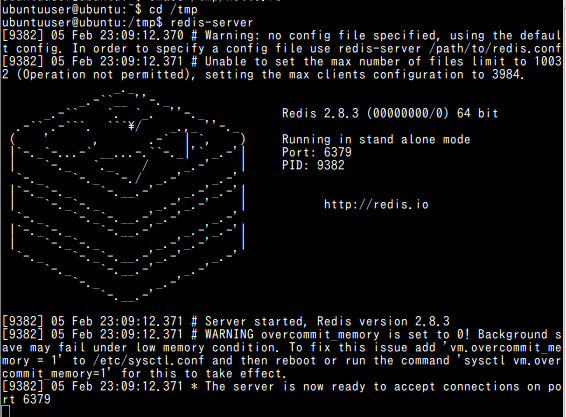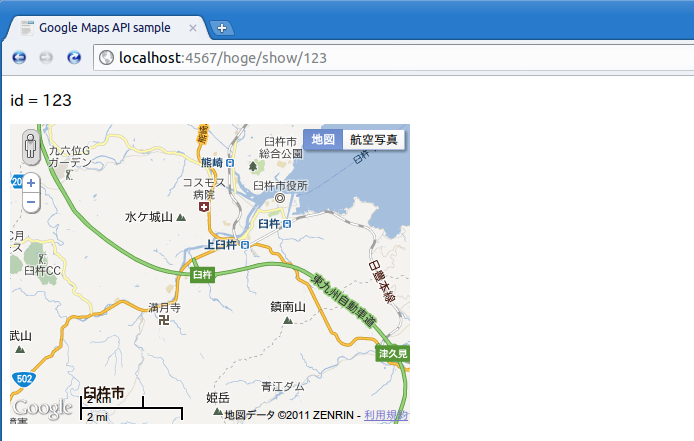Sinatra をインストールし,使ってみる
Sinatra をインストールし,使ってみる<。Sinatra のインストールは簡単です
In this Web pager, installing and using Sinatra is explained.
Sinatra をインストールし,使ってみる (Install Sinatra and try to use it)
◆ インストール (Install)
- ruby, rubygesm, sinatra のインストール (Install ruby, rubygems and sinatra)
◆ Ubuntu での実行手順例 (Instal Sinattra on Ubuntu)
# パッケージリストの情報を更新 sudo apt update sudo apt -y install ruby sudo apt -y install ruby-dev sudo apt -y install rubygems sudo gem install sinatra

- erubis, eruby のインストール (Install erubis and eruby)
# パッケージリストの情報を更新 sudo apt update sudo apt -y install erubis sudo apt -y install erubis-doc sudo apt -y install liberubis-ruby
◆ テスト実行 (try to use using a simple example)
* Classic スタイルの場合 (In case of "Classic Style" of Sinatra)
- ファイル hi.rb を作成 (edit hi.rb)
require 'rubygems' require 'sinatra' get '/hi' do erubis "Hello World!" end

- サーバの起動 (execute a server)
ruby hi.rb
◆ Ubuntu での実行手順例 (In case of Ubuntu)

- Web ブラウザを使って開いてみる (Open a Web page using Web browser)
http://localhost:4567/hi

* Moudlar スタイルの場合
- ファイル hi.rb を作成 (edit hi.rb)
require 'rubygems' require 'sinatra/base' class MyApp < Sinatra::Base get '/hi' do erubis "Hello World!" end end MyApp.run! :host => 'localhost', :port => 4567
- 起動
ruby hi.rb
◆ Ubuntu での実行手順例

- Web ブラウザを使って開いてみる
http://localhost:4567/hi

◆ 試しに使ってみる (try to use)
- redis サーバの起動
cd /tmp redis-server

- ファイル hello.rb を作成 (edit hello.rb)
require 'rubygems' require 'redis' require 'erubis' require 'sinatra/base' class MyApp < Sinatra::Base get '/hoge/new/key=:key&&field=:field&&value=:value' do @redis = Redis.new(:host => "127.0.0.1", :port => "6379", :db => "hoge") @redis.hset(params[:key], params[:field], params[:value]) end get '/hoge/show' do @redis = Redis.new(:host => "127.0.0.1", :port => "6379", :db => "hoge") @keys = @redis.keys(glob = "*") erb :show end get '/hoge' do @redis = Redis.new(:host => "127.0.0.1", :port => "6379", :db => "hoge") @keys = @redis.keys(glob = "*") erb :show end end MyApp.run! :host => 'localhost', :port => 4568 - ファイル views/show.erubis を作成 (edit views/list.erubis)
<HTML> <BODY> <table> <tr> <td width="150">key</td> <td width="150">field</td> <td width="150">value</td> </tr> <% @keys.each do |key| %> <% @fields_and_values = @redis.hgetall(key) %> <% @fields_and_values.each do |field_and_value| %> <tr> <td><%= key %></td> <td><%= field_and_value[0] %></td> <td><%= field_and_value[1] %></td> </tr> <% end %> <% end %> </table> - 起動
ruby hello.rb
◆ Ubuntu での実行手順例

- Web ブラウザを使って開いてみる
http://localhost:4568/hoge/new/key=T:2&&field=x&&value=101

次に http://localhost:/hoge/show

Sinatra を使ってみる
ここで行うこと
- ルーティング: リクエスト URL のパターンマッチングを行い、種類 ごとに特定の処理を行う
- HTML エスケープ: 「<」や 「>」などの文字がそのまま Web ブラウザに送られると問題がある。HTMLエスケープのためのメソッドを定義し使う。
- テンプレートを使って, 動的に「表示させたいもの」を生成する。 その形式は HTML ファイルであったり,オブジェクトであったり.
- レイアウト
レイアウトとテンプレートは別物(別ファイル). テンプレートで生成されたものがレイアウトを経由してHTMLになる,というようにできる. このように2段階に分けて何が嬉しいかというと、 例えば、 「HTTP_X_PJAX: :layout => !(env['HTTP_X_PJAX'])」のように指定したとします.
このとき、X-PJAX がない場合は、「レイアウト」を用いてレンダリングしたHTMLを返す。 X-PJAX がある場合は、 「レイアウト」を使わない。
ここで行うルーティングは下の通り。
| REST URL | without REST | 処理 |
| GET /hoge | GET /hoge/show | 「... => index」と表示 |
| GET /hoge/new | GET /hoge/new | 「... => new」と表示 |
| GET /hoge/[id]:edit | GET /hoge/edit/[id] | 「... => edit ...」と表示 |
| GET /hoge/[id] | GET /hoge/show/[id] | 「... => show ...」と表示 |
| DELETE /hoge/[id] | GET /hoge/destroy/[id] | 「... => destroy ...」と表示 |
| PUT /hoge/[id] | POST /hoge/update/[id] | 「... => update ...」と表示 |
| POST /hoge | POST /hoge/create | 「... => create ...」と表示 |
◆ ルーティング(テンプレート無し,レイアウト無し)の例
- 次のファイルを作り、hi.rb のようなファイル名で保存する (edit "hi.rb")
HTML エスケープのためのメソッドとして hを定義している。
require 'rubygems' require 'sinatra/base' require 'erubis' class MyApp < Sinatra::Base helpers do # define method "h" to escape HTML include Rack::Utils; alias_method :h, :escape_html end get '/hoge' do erubis h "GET <</hoge>> => index" end get '/hoge/show' do erubis h "GET <</hoge/show>> => index" end get '/hoge/new' do erubis h "GET <</hoge/new>> => new" end get %r{^/hoge/([0-9]+):edit$} do erubis h "GET <</hoge/#{params[:captures]}>> => edit #{h params}" end get %r{^/hoge/edit/([0-9]+)$} do erubis h "GET <</hoge/edit/#{params[:captures]}>> => edit #{h params}" end get %r{^/hoge/([0-9]+)$} do erubis h "GET <</hoge/#{params[:captures]}>> => show #{h params}" end get %r{^/hoge/show/([0-9]+)$} do erubis h "GET <</hoge/show/#{params[:captures]}>> => show #{h params}" end delete %r{^/hoge/([0-9]+)$} do erubis h "DELETE <</hoge/#{params[:captures]}>> => destroy #{h params}" end get %r{^/hoge/destroy/([0-9]+)$} do erubis h "GET <</hoge/destroy/#{params[:captures]}>> => destroy #{h params}" end put %r{^/hoge/([0-9]+)$} do erubis h "PUT <</hoge/#{params[:captures]}>> => update #{h params}" end post %r{^/hoge/update/([0-9]+)$} do erubis h "POST <</hoge/updte/#{params[:captures]}>> => update #{h params}" end post '/hoge' do erubis h "POST <</hoge>> => create #{h params}" end post '/hoge/create' do erubis h "POST <</hoge/create>> => create #{h params}" end end MyApp.run! :host => 'localhost', :port => 4567Sinatra でのルーティングの要点
- Sinatra では get, post, put, delete メソッドがある.
- get, post, put, delete メソッドのあとにルートのパターンを書く
- get, post, put, delete メソッドを複数書いた場合には、先頭から順に評価される。マッチするものがあればルーティングが行われ、それ以降は評価されない。
- ルートのパターンに、
正規表現を含めることができる
例:「%r{^/hoge/([0-9]+):edit$}」
「^」が行頭,「$」が行末(これらを省略した場合には、任意の部分文字列にマッチングする)
- ルートのパターンに、名前付きパラメータを含めることができる
例:「/hoge/:act」
名前はなんでも良い。ここでは名前は「act」。 名前付きパラメータで取得した値は 「#{params[:path]}」のようにして,簡単に得ることができる.
- ルートのパターンに、「*」を含めることができる
- get '/hoge/:path' は,/hoge/a にはマッチするが /hoge/a/b や /hoge/a/b/c にはマッチしない
- get '/hoge/*' は,/hoge/a にも /hoge/a/b にも /hoge/a/b/c にもマッチ
- URL 内のパラメータの取得
URL 内のパラメータ(例えば「?a=100」のようなもの)は, params[:a]で取得できる
- 起動
ruby hi.rb
- Web ブラウザを使って開いてみる
下のように 「<</hoge/show/123>>:」のように表示される(たしかにHTML エスケープが行われている)
-
http://localhost:4567/hoge/show
- http://localhost:4567/hoge/new

- http://localhost:4567/hoge/edit/123

- http://localhost:4567/hoge/show/123

- http://localhost:4567/hoge/destroy/123


- http://localhost:4567/hoge/new
◆ ルーティング(テンプレート有り,レイアウト無し)の例
- 次のファイルを作り、hi.rb のようなファイル名で保存する (edit "hi.rb")
「, :locals => {:id => "#{params[:captures]}" }」 の部分は,erubis ファイルの中で使いたいローカル変数の設定を行っている.
require 'rubygems' require 'sinatra/base' require 'erubis' class MyApp < Sinatra::Base helpers do # define method "h" to escape HTML \ include Rack::Utils; alias_method :h, :escape_html end get %r{^/hoge/show/([0-9]+)$} do erubis :show, {:id => "#{params[:captures]}" } end end MyApp.run! :host => 'localhost', :port => 4567 - views/show.erubis ファイルの作成
Sinatra の流儀では、 テンプレート・ファイルは,デフォルトでは,/views ディレクトリ下に置くことになっている。
テンプレート・ファイルのファイル名には、拡張子「.erubis」を忘れないこと。
<HTML> <BODY> <p> id = <%= h id %> </BODY> </HTML>
- 起動
ruby hi.rb
- Web ブラウザから使ってみる
http://localhost:4567/hoge/show/123
下のように /views/show.erubis の評価結果が、 「id = 123」のように表示される

◆ erubis ファイルの中で Ruby のメソッド呼び出し
〜.erubis ファイルの中で,他の Ruby ファイルを取り込みたい. これは,Ruby ファイルで,クラスや関数を定義しておいて, 〜.erubis ファイルの中で使いたいということです.
- 先ほどの「erubis ファイルをビューファイルとして使う」での hi.rb をそのまま使う (use the previout "hi.rb")
- hoge.rb の例 (edit views/hoge.rb)
def f(n) 2 * n end
- views/show.erubis ファイルの作成
Sinatra の流儀では、 テンプレート・ファイルは,デフォルトでは,/views ディレクトリ下に置くことになっている。
拡張子「.erubis」を忘れないこと。
<HTML> <BODY> <p> <% require 'views/hoge.rb' %> <p> id = <%= h id %> <p> f id = <%= f id.to_i %> </BODY> </HTML>
- Web ブラウザから使ってみる
http://localhost:4567/hoge/show/123
下のように /views/show.erubis の評価結果が 表示される。「f 123 = 246」の部分は、Ruby のメソッドの評価結果を表示している。 これは、erubis ファイルでは「f id = <%= f id.to_i %>」の部分である。

◆ erubis ファイルの中で JavaScript を使ってみる。
「erubis ファイル」と言っているのは、HTML の中に erubis のプログラムが埋め込まれたようなものであった。 HTML なので JavaScript を使うことも問題なく行える(Sinatra の側で何かの設定を行うようなことはない)。 念のため試してみる。
- 先ほどの「erubis ファイルをビューファイルとして使う」での hi.rb をそのまま使う (use the previout "hi.rb")
- views/show.erubis ファイルの作成
Sinatra の流儀では、 テンプレート・ファイルは,デフォルトでは,/views ディレクトリ下に置くことになっている。
拡張子「.erubis」を忘れないこと。
<!DOCTYPE html public "-//W3C//DTD HTML 4.01 Transitional//EN" "https://www.w3.org/TR/html4/loose.dtd"> <html xmlns="http://www.w3.org/1999/xhtml" xml:lang="ja" lang="ja"> <head> <meta http-equiv="Content-Type" content="text/html; initial-scale=1.0; charset=utf-8" /> <meta http-equiv="Content-Style-Type" content="text/css" /> <meta http-equiv="Content-Script-Type" content="text/javascript" /> <meta http-equiv="MSThemeCompatible" CONTENT="yes" /> <title>Google Maps API sample</title> <script type="text/javascript" src="https://maps.google.com/maps/api/js?sensor=false"></script> <script type="text/javascript"> <!-- google.maps.event.addDomListener(window, 'load', function() { var latlng = new google.maps.LatLng(33.104053, 131.78092); var myOptions = { zoom: 12, center: latlng, mapTypeId: google.maps.MapTypeId.ROADMAP, scaleControl: true, }; var map = new google.maps.Map(document.getElementById("googlemap"), myOptions); }); // --> </script> </head> <body style="width : 500px; height : 400px;"> <p> id = <%= h id %> <p> <div id="googlemap" style="width : 400px; height : 300px;"></div> </body> </html> - Web ブラウザから使ってみる
http://localhost:4567/hoge/show/123
下のように /views/show.erubis の評価結果が 表示される。

◆ erubis ファイルの中で JavaScript を使ってみる。
「erubis ファイル」と言っているのは、HTML の中に erubis のプログラムが埋め込まれたようなものであった。 HTML なので JavaScript を使うことも問題なく行える(Sinatra の側で何かの設定を行うようなことはない)。 念のため試してみる。
- 次のファイルを作り、hi.rb のようなファイル名で保存する (edit "hi.rb")
require 'rubygems' require 'sinatra/base' require 'erubis' class MyApp < Sinatra::Base helpers do # define method "h" to escape HTML \ include Rack::Utils; alias_method :h, :escape_html end get '/hoge/show' do erb :show end get '/hoge/new' do erb :new end post '/hoge/create' do erb :create, :locals ='> {:params ='> params } end end MyApp.run! :host ='> 'localhost', :port ='> 4567 - views/show.erubis ファイルの作成
<!DOCTYPE html public "-//W3C//DTD HTML 4.01 Transitional//EN" "https://www.w3.org/TR/html4/loose.dtd"> <html xmlns="http://www.w3.org/1999/xhtml" xml:lang="ja" lang="ja"> <head> <title>show</title> </head> <body> <% require 'rubygems' %> <% require 'sqlite3' %> <% db = SQLite 3::Database.new("/home/windowslike/views/mydb") %> <% a = db.execute("SELECT * FROM persons;") %> <% db.close() %> <%= a %> </body> </html> - views/new.erubis ファイルの作成
<!DOCTYPE html public "-//W3C//DTD HTML 4.01 Transitional//EN" "https://www.w3.org/TR/html4/loose.dtd"> <html xmlns="http://www.w3.org/1999/xhtml" xml:lang="ja" lang="ja"> <head> <title>new</title> </head> <body> <p>Please input your name</p> <form action='/hoge/create' method='POST'> <p> name: <input type='text' name='name'> <p> commente: <input type='text' name='comment'> <p> <input type='submit' value='Send'> </form> </body> </html> - views/create.erubis ファイルの作成
<!DOCTYPE html public "-//W3C//DTD HTML 4.01 Transitional//EN" "https://www.w3.org/TR/html4/loose.dtd"> <html xmlns="http://www.w3.org/1999/xhtml" xml:lang="ja" lang="ja"> <head> <title>create</title> </head> <body> <p> name = <%= params[:name] %> <p> comment = <%= h params[:comment] %> <% require 'rubygems' %> <% require 'sqlite3' %> <% db = SQLite 3::Database.new("/home/windowslike/views/mydb") %> <% db.execute("insert into persons values ( '#{params[:name]}', '#{params[:comment]}' )") %> <% db.close() %> </body> </html> - 起動
ruby hi.rb
- Web ブラウザから使ってみる
http://localhost:4567/hoge/new
![[kaneko lab.]](https://www.kkaneko.jp/info/logo_png.png)